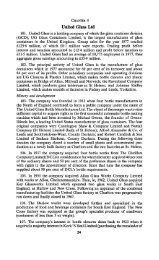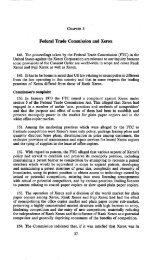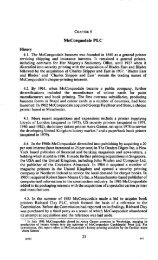3 The market for impulse ice cream [per] - Competition Commission
3 The market for impulse ice cream [per] - Competition Commission
3 The market for impulse ice cream [per] - Competition Commission
- No tags were found...
You also want an ePaper? Increase the reach of your titles
YUMPU automatically turns print PDFs into web optimized ePapers that Google loves.
3.108. This view presumably reflected an assumption that any would-be new entrant would produce the same<strong>impulse</strong> <strong>ice</strong> <strong>cream</strong> as existing firms. What Mars did in 1989 was to develop a new segment to the <strong>market</strong>. In thecurrent inquiry Mars told us that despite its successful launch of confectionery-based <strong>ice</strong> <strong>cream</strong> products in 1989,freezer exclusivity did not allow its innovation to achieve a level of <strong>market</strong> penetration that enabled it to competeeffectively against BEW and Lyons Maid. However, BEW told us that by 1993, according to Nielsen data, Mars,notwithstanding its narrow product range, was present in 58 <strong>per</strong> cent of CTNs, independent grocers and garages(73 <strong>per</strong> cent if weighted according to turnover). At a regional level it has been difficult to assess the level ofpenetration as Nielsen data do not give regional <strong>market</strong> shares.3.109. We now consider various aspects of <strong>market</strong> entry in the light of the above comments.Access to outlets3.110. In nearly all food <strong>market</strong>s a new brand has to fight <strong>for</strong> shelf space with a large number of existingbrands, some of them strongly entrenched in the consumer's mind. In the case of <strong>impulse</strong> <strong>ice</strong> <strong>cream</strong> the uniquerequirement of a freezer cabinet increases the difficulty <strong>for</strong> the entrant. <strong>The</strong> entrant has various options. He cangain access to an existing cabinet by <strong>per</strong>suading the retailer, if the freezer is his, to give the space to try the newproducts or by <strong>per</strong>suading the manufacturer, if the cabinet is his, to distribute the additional product or range. Hecan replace an existing manufacturer's cabinet. He can supply an additional cabinet. He can <strong>per</strong>suade the retailerto buy a cabinet thus eliminating any problems of exclusivity. An alternative <strong>for</strong>m of entry via the supply ofown-label products is possible in the retail grocery trade. Own label is, however, a very minor part of the <strong>impulse</strong><strong>ice</strong> <strong>cream</strong> <strong>market</strong>.3.111. If a new entrant is to sell <strong>ice</strong> <strong>cream</strong> through an outlet that already has a cabinet supplied `free', but onan exclusive basis, then it faces the need to <strong>per</strong>suade the retailer to displace the cabinet of the establishedmanufacturer. <strong>The</strong> retailer may regard switching to a new supplier as being unattractive if it means he losesaccess to established brands. In this case the retailer may consider the option of purchasing his own nonexclusivecabinet. <strong>The</strong> alternative course of action is <strong>for</strong> the retailer to take an additional cabinet from the newentrant. This option is only possible where the outlet has space <strong>for</strong> a second cabinet and even then is only likely ifthe <strong>per</strong>ceived return on the space allocated to a second cabinet exceeds that obtainable from using the spacecurrently devoted to stocking another product. In this case, however, the retailer has the option of taking twosmaller manufacturers' cabinets in place of his existing one.3.112. As far as an entrant is concerned provision of a cabinet to a retailer, whether to displace one owned byan established manufacturer or to stock the new product range in a second cabinet, involves expenditure. Thisexpense required of a small entrant will be significant if such a firm aims to become a major supplier even withina small geographical area let alone the whole national <strong>market</strong>. However, this is an expense which has to be borneby anyone supplying the <strong>market</strong>. Further, the costs of cabinet provision may be less than the <strong>market</strong>ing costsrequired to develop national brands as has been shown above in the case of Mars in 1992.Development of brands3.113. For any potential entrant into any retail food grocery <strong>market</strong> a successful brand launch requires that thenew brand should be popular with consumers, wholesalers and retailers. Persuading wholesalers and retailers tostock a new brand is helped either if the supplier can build on an existing brand as Mars and Nestlé are able todo, or if such a launch is accompanied by a major advertising campaign, particulary if the entrant is seekingnational distribution.Product range3.114. In the case of the <strong>impulse</strong> <strong>ice</strong> <strong>cream</strong> <strong>market</strong> an entrant who does not offer retailers a full product rangemay find <strong>market</strong> penetration difficult. Retail outlets need to meet a varied pattern of consumer demand, as41


![3 The market for impulse ice cream [per] - Competition Commission](https://img.yumpu.com/41909865/28/500x640/3-the-market-for-impulse-ice-cream-per-competition-commission.jpg)

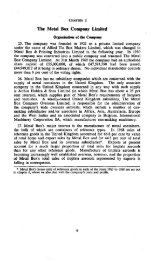

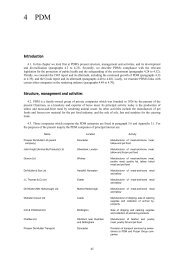
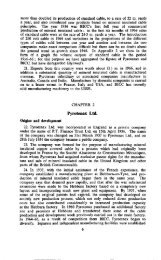
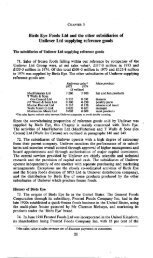
![Ch 3 UK market for car parts [per] - Competition Commission](https://img.yumpu.com/33043800/1/184x260/ch-3-uk-market-for-car-parts-per-competition-commission.jpg?quality=85)


